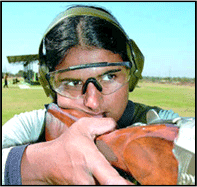by Irwin Greenstein
The years passed in Colorado, he got married, had kids, and had not picked up a shotgun in nearly a decade. That would’ve been around 1970.
Now it’s 1996, and Michael Sabbeth vividly recalls that pivotal moment in the Denver suburb of North Cherry Creek…
“I’m in my law office, it’s lunch time and I get out and walk to a sandwich shop. That’s when I run into my friend, John, who I hadn’t seen in several years since he moved to Florida.
He had been a very dear friend who was a stock broker. He was an avid shooter, competitive trap. And we used to shoot together. After he moved away, the shooting sports became very ephemeral for me.”
The two old friends were catching up when John invites Michael over to his apartment.
“When I go over there, it’s covered with gun magazines, guns, reloading supplies…you name it. It was there that I picked up my first issue of Double Gun Journal. I had never seen anything like it, and I was very intrigued. I leafed through it, this world of elegant guns, travel, clothing, leather — it all came at me like a sandblaster. I asked if I could borrow a few issues. John then made a comment: ‘You want to be a big shot? See if you can get published in this magazine.’ There was no reason for him to say that because I never expressed any interest in the magazine. I had never written about guns. But as I looked the magazines over the next several weeks, I had an intuition that if I could get published in that magazine, something good would happen, something elegant and out of the ordinary in my life.”
And over the ensuing weeks Michael did in fact come up with an idea to submit to Double Gun Journal. The topic? Teaching the ethics of shooting to children.
“They sent me a handwritten card that they would publish the article, and not pay me for it. That’s how I got involved in the gun trade.”
Journey to Spain
After that breakthrough article, Michael’s next assignment for the esteemed Double Gun Journal took him to Spain for a story about the exquisite gun maker, Kemen.
Michael traveled to the town of Elgoibar. “That is one of the two gun-making cities in the Basque region, in the province of San Sebastian. I called my wife, Nancy, to tell her I was OK. She asked where I was. I told her a tapas bar and she blew up — thinking that I was at a topless bar,” he says, laughing.
After the Kemen article, Michael says he got his first big break in writing about shotguns.
Visiting Beretta in Italy
In 1999 Beretta acquired Benelli and Franchi. As a foundational advertiser for Double Gun Journal, Beretta offered the magazine an exclusive about the merged company. Double Gun Journal turned to one of their long-standing writers, but something went sour with the writer. That’s when editor/publisher Daniel Côté turned to Michael, who flew to Italy for a week-and-half on an all-expense paid trip to cover the story.
With that trip, “I had to ratchet up my understanding of shotguns voluminously,” he recalls. “That started me writing about many other guns. And as a consequence I was received warmly by gun makers and then transformed those relationships into articles.”
Michael believes that his deeper understanding of shotguns played a role in synthesizing his collected passions into a whole way of life.
“The great things about the shotguns, it has given a purpose for many disparate and unrelated aspects of life…food, wine, travel,” he says “I’m now seeing things that I would not have seen. Exquisite sunsets, a double rainbow — the collegiality — and meeting some of the esteemed craftsman and women on the planet. All of which has enriched my life immeasurably.”
And an enriched life is the one thing that Michael does not take for granted. In 1989, he survived surgery for an artificial heart-valve implant. “Being close to death made me value those people who strive for excellence in their craft: the heart surgeon, the chemist, the biologist, those people who created the artificial heart valve, and all of those wonderful nurses and staff who were so competent and expert who allowed me to live. I felt very blessed to have survived, and I thought, now that I’ve had this good fortune, what can I do?”
Repaying a Cosmic Debt
To repay his “cosmic debt,” Michael developed a curriculum that teaches ethics to elementary school children. While recovering from the implant, Michael crafted a course to make it easier for young people to more critically analyze the consequences of their choices, with the hope that they will ultimately make the right choices as they get older.
He started with the students at Cherry Hills Elementary School in his hometown of Cherry Hills Village, Colorado.
From Michael’s perspective, ethics is shorthand for applying moral reasoning to problems such as racism or peer pressure. It’s a form of character education to engage students to work hard to reduce bullying, sexual harassment and drugs in schools.
In effect, Michael uses current, historical and personal events in the lives of the children to frame an ethical theory. His approach is to stimulate conversations about issues that most adults believe are over their heads.
The conversations allow the children to use terms such as the “sanctity of life” and “beneficence.” What Michael achieves is a format that helps them understand how to make choices, that in turn can help other people, and help elevate humanity.
11 Concepts
At the core of Michael’s curriculum are 11 ethical concepts that he calls The Moral Measures..
Four of them are universal ethical principles drawn from the writings of Aristotle and biomedical ethics. They are autonomy, beneficence, justice, and sanctity of life.
The others are the “Seven C’s,” which Michael devised. They are character, choices, compassion, competence, consequences, conscience, and courage.
Michael has since conducted his program more than 500 times. It has gone beyond children to first responders as well. His efforts have garnered him an impressive article in the Christian Science Monitor in 2002.
His ethics course also set Michael on a path of what he calls the “political aspect of gun ownership.” He has become involved in Second Amendment issues — lecturing nationally.
“I’ve become politically involved in the general field of selectively defending and advocating gun ownership rights,” he says. “That involvement with guns as an advocate, has enhanced many relationships, and is generally very well received.”
Among Michael’s accomplishments, perhaps those most cherished are the friendships he’s developed with the most elite shotgun makers in Italy.
The Craftsmen of Gardone
It started in 1997, when Michael and his wife traveled to Switzerland and Italy to celebrate his fiftieth birthday. After racking up miles of skiing in the Swiss Alps, they took a train to Milan…and then to Gardone, where craftsmen have excelled in making fine shotguns for more than 500 years.
Through introductions from Double Gun Journal, he met Italy’s greatest artisans of the shotgun craft — many of whom are still his friends today.
There was engraver extraordinaire, Mauro Dassa. His company Incisioni Dassa has engraved numerous Beretta premium shotguns, including stunning new SO 10 models, which can cost upwards of $80,000.
Dassa then introduced Michael to other Italian shotgun legends.
Ivo Fabbri, who at the time made shotguns in the basement of his house — using state-of-the-art computer systems. Fabbri shotguns then started at $90,000. At the 2008 Safari Club Convention, they were selling for over $250,000. Making only 30 shotguns a year, Fabbri’s clientele include Steven Spielberg, Tom Selleck and King Juan Carlos of Spain.
There was Piotti Fratelli, who is widely respected as among Italy’s premier gunmakers. Their shotguns and rifles are made to individual order — tailored to meet the customer’s specifications. The result is an elegant gun that has been rated among the top-10 shotguns produced in the world today.
He also met Elio and Remigio Bertuzzi. The brothers learned to build shotguns from their father and grandfather. Working in a space no bigger than a garage, they only make 10-15 shotguns annually — each one a collector’s prize.
Michael also visited FAMARS di Abbiatico y Salvinelli. In their small factory, they helped usher in the computer-designed artisan shotgun replete with stunning, old-world engraving. Starting at the $25,000 price point, a stunning .470 N E Express double rifle sold for $165,000 at the 2008 Safari Club Convention.
From Vail to Italy
But one of Michael’s greatest memories is about the improbable connection between a modest Beretta semi-automatic shotgun and Beretta’s Patriarch, Ugo Guassalli Beretta.
The story starts on a road trip to Vail, Colorado in 2001. He was going to drive his daughter, Alexandra, then 13, to a friend’s bat mitzvah, when he remembered that Piney Valley Ranch Sporting Clays Club. was about 20 miles west of their destination. He asked her if she would mind bringing a book to read so he could shoot afterwards.
After the bat mitzvah, as they approach Piney Valley Ranch, his daughter said that she would rather go shooting with him than sit around and read. The only shotgun he had on the trip was a Dassa-engraved Perazzi that weighed about 8½ pounds. Michael knew it was too heavy for his daughter. Fortunately, Piney Valley Ranch just took possession of a new Beretta 391 Urika youth model 20-gauge shotgun, an ideal shotgun for his young daughter. They went trekking off into the mountains to do some shooting.
Well, not only did she run the first station, but she “creamed” the course, Michael says. “She was outstanding. I was stunned.”
The following month, he was Beretta’s guest for a week to write an article for Double Gun Journal about the seven extraordinary shotguns and rifles built as a surprise gift honoring the birthday of Ugo Gussalli Beretta. On the afternoon of his last day there, he found himself in a large conference room behind the world-famous Beretta museum. In attendance is the family patriarch, Ugo Gussalli Beretta — a direct descendant of Maestro Bartolomeo Beretta who started the company in 1526.
As they are admiring the collection of shotguns on the velvet-covered table, Michael began telling the story about his daughter’s incredible sporting-clays game at Piney Valley Ranch.
Realizing that the Urika youth model was constructed merely 200 yards away in the Beretta ‘industrial’ facility, and in a moment of inspired enthusiasm, he ordered the shotgun directly from the boss himself, Ugo Gussalli Beretta. Michael’s only request was that the names of his two younger children, Erik and Alexandra, be engraved on the receiver — one name on each side.
“Then, Mr. Beretta, one of the wealthiest and most powerful people in Europe, excitedly said ‘We put today’s date on the gun.’ Michael recollects. “Here’s this industry titan and he’s as exuberant as if he’d just made the largest sale in the company’s history. It was a magical moment. Now I have the gun, but more importantly I have the story. The cost of the gun was not at all that much, but the story, well, that is priceless.”
Useful resources:
http://www.kemenarmas.es/web_en.asp
http://www.fabbri.it/
http://www.piotti.com/
http://www.famars.com/
http://www.doublegunshop.com/doublegunjournal.htm
http://www.clayshootingusa.com/readers/archive/jul_aug06/Modern%20Classics.pdf
http://www.pineyvalley.com/shooting-sports.shtml
http://www.berettausa.com/product/product_competition_guns_main.htm
http://www.beretta.com/















 Having been in the outdoor related business for 50 years, I’ve met only one other person who’s a better hunter than Jimmy E. — and that man is deceased.
Having been in the outdoor related business for 50 years, I’ve met only one other person who’s a better hunter than Jimmy E. — and that man is deceased.